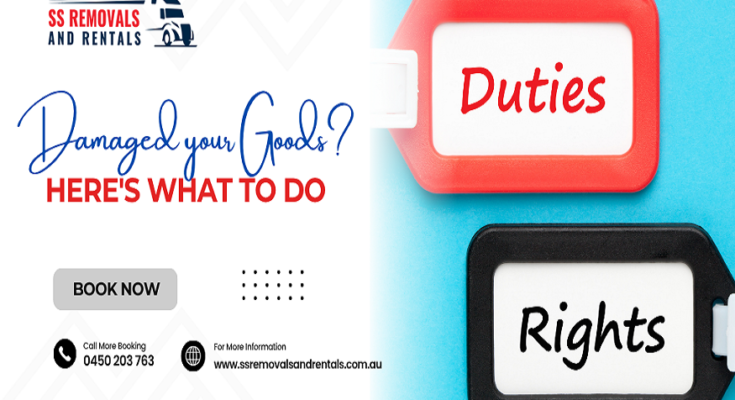Moving house is a significant life event, often bringing a mix of excitement and stress. Amidst the packing, planning, and anticipation of a new beginning, the last thing anyone wants to encounter is damaged belongings. Unfortunately, accidents can happen, and sometimes, your valued possessions might not arrive at your new home in the same condition they left your old one.
If you’re in Brisbane and your furniture removalists have caused damage during your move, this comprehensive guide will walk you through the essential steps to take.
At SS Removals and Rentals in this blog helps you understand your rights under Brisbane Consumer Law (ACL) and shows you how to seek a fair resolution.
Prevention is Better Than Cure (Pre-Move Tips)
Proactive steps can significantly reduce the likelihood of damage and strengthen your position if something does go wrong.
Choose Wisely
The foundation of a stress-free move starts with selecting the right removalist company. Don’t just go for the first or seemingly cheapest option. Research reputable removalists by checking online reviews, asking for recommendations from friends and family, and looking for companies with a proven track record.
A key indicator of reliability is membership in the Brisbane Furniture Removers Association (AFRA). AFRA members adhere to a strict code of conduct and offer an independent mediation service, providing an extra layer of protection for consumers.
Get multiple quotes in writing, ensuring they detail all services included, so there are no surprises later. While budget removalists or cheap removalists might seem appealing, ensure they don’t compromise on professionalism and care.
Understand Your Contract
Before signing anything, meticulously read the terms and conditions of your removalist’s contract, paying particular attention to clauses regarding liability for damage and removalist insurance. Be wary of clauses that attempt to deny all responsibility for damage; such clauses are often illegal under the ACL. A reputable removalist company will be transparent about its responsibilities.
Insurance Matters
Understanding insurance coverage is paramount.
- Removalist’s Insurance: Most furniture removalists carry public liability insurance and sometimes transit insurance. However, it’s crucial to understand what their insurance covers and its limitations. Often, it may not cover the full replacement value of your items and might only cover specific types of damage.
- Your Insurance: Strongly consider taking out your transit insurance. This is often the most comprehensive way to protect your belongings during a move. Also, check if your existing home and contents insurance policy covers items during a move, as some policies offer this as an add-on or standard feature. This provides broader protection against various risks.
- AFSL: If a removalist offers to sell you insurance, they must hold a Brisbane Financial Services License (AFSL) or be an authorised representative of one. Verify this to ensure they are legally permitted to offer such products. This applies to both affordable removalists and premium services.
Document Everything
Thorough documentation is your best friend if damage occurs.
- Before the Move: Take clear, time-stamped photos or videos of all valuable or easily damaged items from multiple angles.
- Packing: If you’re self-packing, ensure your items are properly secured and cushioned. If the removalist is undertaking the packing, supervise the process and ensure they use appropriate packing materials and techniques.
Damage Occurred! What to Do Immediately (On Moving Day)
Discovering damaged belongings can be upsetting, but acting quickly and methodically is crucial.
Don’t Panic, But Act Quickly
As soon as your belongings are unloaded, begin a thorough inspection. Compare the condition of items against your pre-move photos and inventory.
Document the Damage
Capture close-up shots showing the specifics of the damage, as well as wider shots showing the item and its location in relation to other belongings. Note the exact date and time you discovered the damage.
Notify the Removalist
- Immediately: Inform the furniture removalists staff on-site about the damage as soon as you discover it. Point out the issues clearly and politely.
- In Writing: Follow up with a written notification to the removalist company as soon as possible, ideally within 24-48 hours. Email is usually the best option as it provides a clear timestamp. State precisely what was damaged, how you believe it happened, and when you discovered it.
Do NOT Pay in Full (if possible)
If significant damage is evident, and it’s within your contractual rights, try to withhold a reasonable portion of the final payment until the issue is addressed. This can provide valuable leverage in negotiations.
The Claim Process (Step-by-Step)
Once the initial shock has subsided, it’s time to formally lodge your complaint and begin the claim process.
Formal Written Complaint to the Removalist
Attach all your evidence, including photos, videos, and your pre-move inventory. Clearly state what you expect as a resolution – whether it’s repair, replacement, or financial compensation. Give them a reasonable timeframe to respond, typically 7-14 days.
Refer to Your Contract and Consumer Guarantees
- Australian Consumer Law (ACL): Under the ACL, services provided by removalists must be:
- Provided with due care and skill.
- Reasonably fit for any specified purpose.
- Provided within a reasonable time (if no time is set).
- If the damage is a result of their failure to meet these consumer guarantees, you have a right to a remedy, which could include repair, replacement, a refund, or compensation for the loss.
- “Major” vs “Minor” Failure: Understand the distinction under ACL. A “major failure” means you may be entitled to cancel the contract and get a refund, or seek compensation for the difference in value. This might apply if, for example, an item is irreplaceable or fundamentally destroyed.
Lodge an Insurance Claim (if applicable)
If you have your own transit insurance or removalist insurance through the company, contact your insurer immediately. Follow their claims process diligently, providing all required documentation such as your policy number, photos of the damage, inventory lists, receipts for the damaged items, and all correspondence with the removalist. Be mindful of any excesses you may need to pay and any time limits for filing claims.
Gather Quotes for Repair/Replacement
To support your compensation claim, obtain independent quotes for repairing or replacing the damaged items. This provides objective evidence of the financial loss you’ve incurred.
What if They Don’t Cooperate? (Escalation Options)
If the removalist company is unresponsive or you can’t reach a satisfactory resolution directly, there are avenues for escalation.
Consumer Protection Agencies
If direct negotiation fails, contact your state or territory consumer protection agency. Examples include NSW Fair Trading, Consumer Affairs Victoria, and Consumer and Business Services SA. These agencies can provide advice on your rights and may offer free mediation services to help resolve the dispute. While the ACCC provides general information about consumer rights, it typically does not resolve individual consumer disputes.
Brisbane Furniture Removers Association (AFRA)
If your furniture removalists are AFRA members, you can lodge a formal complaint with them. AFRA offers a dispute resolution process designed to mediate issues between customers and their member companies. This is often a good next step before considering legal action.
Small Claims Tribunal/Court
As a last resort, if all other avenues are exhausted, you can consider taking the matter to a small claims tribunal or court in your state or territory. This involves fees and can be a lengthy process, so it’s advisable to seek independent legal advice if you consider this option.
Discovering damaged belongings after a move is undoubtedly frustrating and disheartening. However, by understanding your rights, meticulously documenting everything, and acting persistently, you can significantly improve your chances of achieving a positive outcome.
Remember, thorough preparation before the move, clear communication immediately after damage is discovered, and persistent follow-up are your key allies. The Brisbane Consumer Law is designed to protect you, and by knowing how to leverage it, you can navigate the challenges of removalist damage with greater confidence.
At SS Removals and Rentals, we’re here to assist you through every step of your move. If you’ve experienced damage or need advice on how to handle a situation, feel free to reach out to our team for support and guidance. Call us today at 0450 203 763 — we’re just a phone call away.
Follow SS Removals and Rentals on Facebook and Instagram for moving tips, updates, and expert advice on handling your relocation smoothly.




